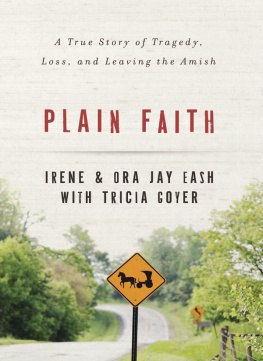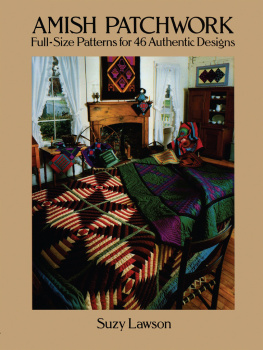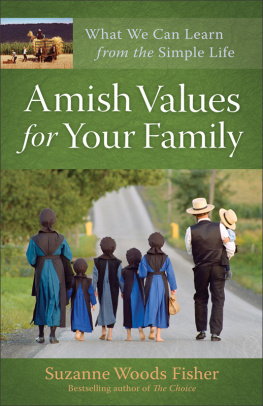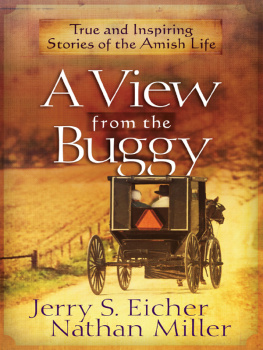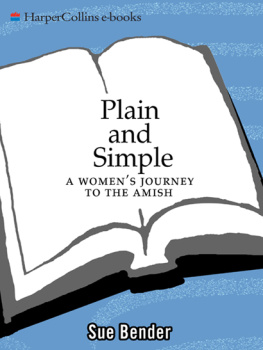As one of the more colorful subcultures in American life, the Amish intrigue us. As outsiders we are drawn to them because of their strong bonds of community, their commitment to family, their strong sense of place, and their stubborn resistance to the mania of technology that often drives modern life. Although we are drawn to them, we rarely have the opportunity to hear genuine Amish voices or listen to the joys and struggles of daily life in Amish homes across the country. In Beyond the Plain and Simple, Pauline Stevick introduces us to many Amish people in different states and communities. She takes us backstage in Amish society and narrates a series of vignettes that provide profound insight into the beauty and the pathos of this distinctive religious community.
With an engaging and inviting writing style, Stevick describes many of the features of Amish life with warmth, sensitivity, and respect. Her writing is not fettered with abstract academic concepts, nor does she sensationalize or stereotype Amish life. In an even-handed style, she introduces us to many common Amish practices as well as to the diversity of Amish life. Instead of focusing on just one family or one community, we hear stories from many different communities and church traditions. The potpourri of stories provides a frank and candid window to the real-life struggles of real people, not the stereotypical postcard figures who are sporting beards and bonnets.
At first blush, the Amish seem so far away from us, living in a different cultural world far from the cosmopolitan culture of urban life. Nevertheless, Stevick takes us on an Amish journey that reveals the ways that we share many of their struggles and concerns. Perhaps most important is the sense of Amish agency that emerges from the text. We hear real Amish people talking about their delights and fears. And as we hear them speak we realize that although we stand on the other side of a cultural fence, all of usAmish and Englishshare common bonds of humanity. That, perhaps, is the most important contribution of this intriguing collection of stories that take us far beyond the plain and simple postcard stereotypes.
The Amish, part of the plain peopleso called because of their plain dress and simple lifestylenever forget their origins in the Reformation in Europe.
The Amish (pronounced Ah-mish), the Mennonites, and the Brethren are descendants of the Anabaptist wing of the Reformation, which had its roots in sixteenth-century Switzerland. Onlookers derisively employed the term Anabaptist to describe a group of followers of the reformer Ul-rich Zwingli who believed he and others had not gone far enough in their reforming practices. After deciding that his practice of infant baptism was contrary to scripture, they rebaptized each other despite their having been baptized as infants. These early Anabaptists insisted that neither church nor parents had the right to baptize an individual unless the individual himself or herself confessed faith in Christ, hence the term believers baptism. For this and other beliefs, based on their determination to interpret and live out scripture as literally as possible, many Anabaptists were severely persecuted, imprisoned, tortured, and killed during the more than two hundred years that followed.
About a century following the original rebaptizing incident, a group of Swiss Anabaptists (Swiss Brethren) who migrated to the Alsatian area of what is now France decided that some of the practices of the Anabaptists they had left behind in Switzerland needed to be reformed. Under the influence of Jacob Amman, they began conducting communion semiannually rather than annually, included the custom of feet washing along with communion, and insisted on a more severe social shunning of disobedient members rather than mere expulsion from religious services. This group subsequently decided on a plainer mode of dress as well. Garnering the support of these followers and others in Bern and the Palatinate region of Germany, Jacob Amman excommunicated the less conservative Swiss Brethren who disagreed with him. Despite attempts at reconciliation, the split was not repaired. Jacob Ammans group became known as Amish, whereas the group they left behind was later called Mennonists or Mennonites, after an influential Dutch leader, Menno Simons.
The Lancaster County, Pennsylvania, Amish group is the most well-known of the Amish enclaves, but it is not the largest.
Like many other persecuted religious persons, Mennonites and Amish immigrated to Pennsylvania during the eighteenth century. Both groups settled in Lancaster County, where they flourished, and later many migrated to many other states as well. While the one hundred-plus districts in Lancaster represent the oldest grouping of Amish, the largest is located in Holmes, Wayne, and Stark counties in Ohio and the third largest is in Elkhart and LaGrange counties in Indiana. However, Amish groups are clustered in areas known to them as settlements in twenty-seven states and Ontario. Within these settlements they are organized in districts, which typically consist of twenty-five to thirty-five families, although in the smaller settlements the number of families may be far fewer. Theoretically, a bishop, two ministers, and a deacon oversee each district, although this does not always work out in practice.
While all Amish groups share a core belief system and similar code of conduct, they are not identical and sometimes do not affiliate with one another.
All Amish groups embrace the basic tenets of the Amish faith, which in addition to adult baptism and a literal obedience to Christ and his teaching, include the separation from the world, a nonviolent lifestyle, and membership in a covenant community. In general, the Amish embrace simplicity and tradition, are suspicious of the effects of new technology on their covenant community, and change beliefs and practices very slowly. Rather than having a written discipline as some church groups do, the Amish agree together upon their mutual system of conduct, or specific rules, which collectively is known as the Ordnung and which is transmitted orally. The Ordnungs of districts and settlements that affiliate with each otherthat is, who exchange preachers and fellowship with one anotherwill be almost identical, whereas a careful observer will note differences in dress style (still plain) and level of technology permitted among nonaffiliating settlements. Of course, the similarities are much more marked than the differences.



